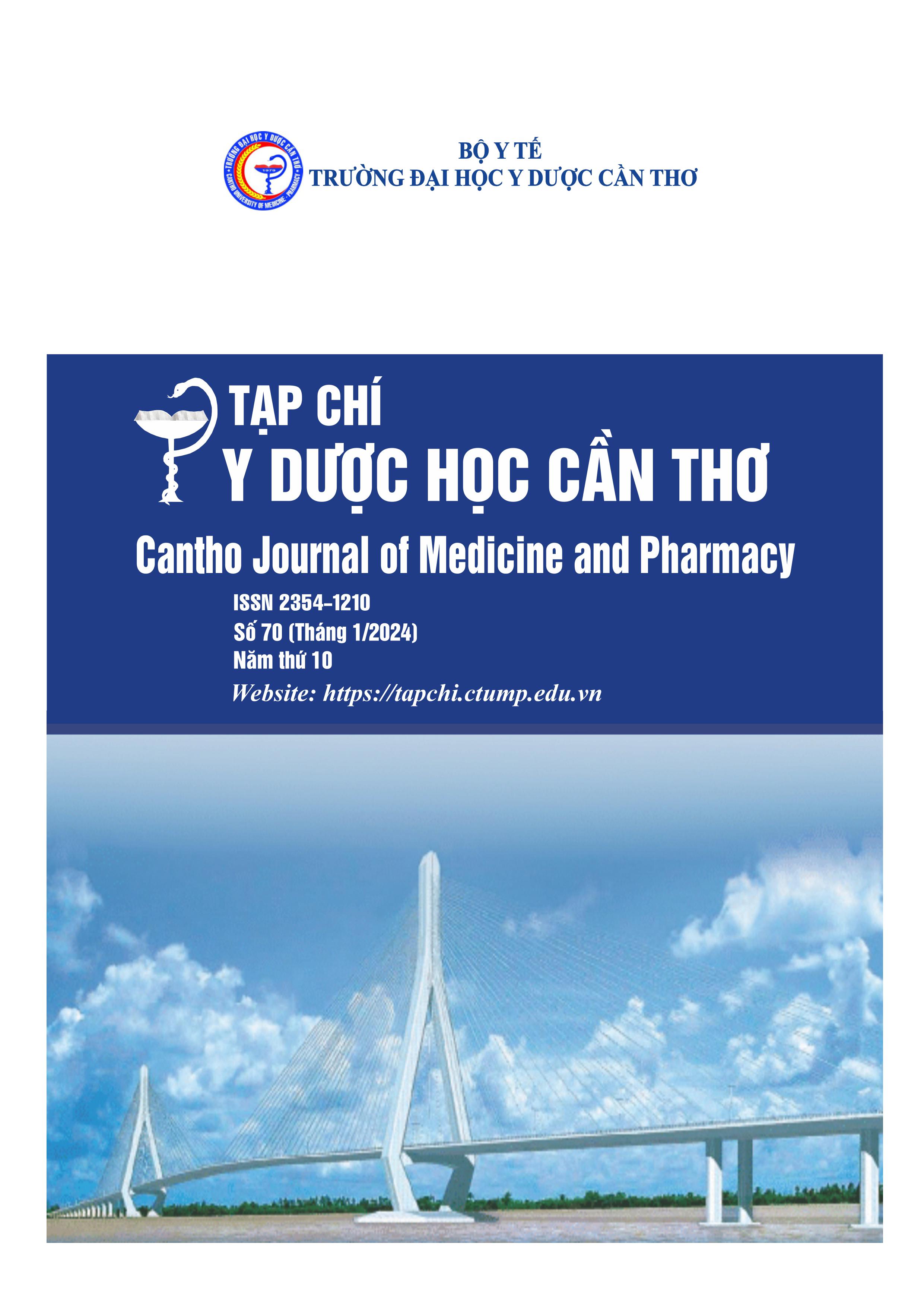SURVEY ON ACUTE NEUROLOGICAL COMPLICATIONS AND RELATED FACTORS IN ISCHEMIC STROKE PATIENTS AT CAN THO CENTRAL GENERAL HOSPITAL
Main Article Content
Abstract
Background: Acute brain complications are dangerous complications that aggravate stroke, prolong hospital stay and increase mortality. Objectives: To determine the rate of acute neurological complications and some related factors in patients with ischemic stroke at Can Tho Central General Hospital. Materials and methods: A cross - sectional study on 76 patients with ischemic stroke. All patients were asked about their medical history, clinical examination, evaluated on the NIHSS scale and had a brain CT scan. Results: The rate of acute neurological complications was 46.05%. The rate of hemorrhagic transformation was 15.8%, Seizure was 3.9% and Cerebral edema was 38.2%. There was an association between NIHSS score at admission and acute neurological complications. Specifically, in the group of patients with an NIHSS score of 5 or higher at admission, the rate of acute neurological complications was higher, and this difference was statistically significant with p < 0.001. Conclusions: Acute brain complications occur at a relatively high rate following ischemic stroke and are associated with the NIHSS score at admission.
Article Details
Keywords
Ischemic stroke, acute neurological complications, NIHSS
References
incidence, prevalence, mortality, and risk factors. Neurologic clinics. 2008. 26(4), 871-895, doi: 10.1016/j.ncl.2008.07.003.
2. Hong, Ji Man, Da Sol Kim, and Min Kim. Hemorrhagic transformation after ischemic stroke: mechanisms and management. Frontiers in Neurology. 2021. (12), doi: 10.3389/fneur.2021.703258.
3. Zöllner, Johann Philipp. National Institutes of Health Stroke Scale (NIHSS) on admission predicts acute symptomatic seizure risk in ischemic stroke: a population-based study involving 135,117 cases. Scientific Reports. 2020. 10(1), doi: 10.1038/s41598-020-60628-9.
4. Escudero-Martínez, Irene et al. Cerebral Edema in Patients with severe Hemispheric Syndrome: Incidence, Risk Factors, and Outcomes—Data from SITS-ISTR. Journal of Stroke. 2022. 25(1), 101-110, doi: 10.5853/jos.2022.01956.
5. Bộ Y Tế. Hướng dẫn chẩn đoán và xử trí đột quỵ não - Quyết định số 5331/QĐ-BYT ngày 23 tháng 12 năm 2020.
6. Ho, Mai-Lan, Rafael Rojas, and Ronald L. Eisenberg. Cerebral edema. American Journal of Roentgenology. 2012. 199(3), W258-W273, doi: 10.2214/AJR.11.8081.
7. Bovim, Martina Reiten. Complications in the first week after stroke: a 10-year comparison. BMC neurology. 2016. (16), 1-9, doi: 10.1186/s12883-016-0654-8.
8. Hong Keun Sik. Impact of neurological and medical complications on 3‐month outcomes in acute ischaemic stroke. European journal of neurology. 2008. 15(12), 1324-1331.
9. Weimar C., Roth M. P., Zillessen G., Glahn J., et al. Complications following acute ischemic stroke, European neurology. 2002, 48 (3), 133- 140, doi: 10.1111/j.1468-1331.2008.02310. x.
10. Dostovic Z., Dostovic E., Smajlovic D., Ibrahimagic O. C., et al. Brain edema after ischaemic stroke, medical archives. 2016. 70 (5), 339. doi: 10.5455/medarh.2016.70.339-341.
11. Chu Văn Vinh. Nghiên cứu đặc điểm lâm sàng, cận lâm sàng và thực tế áp dụng tiêu chuẩn chất lượng về xử trí đột quỵ não ở Việt Nam trên bệnh nhân đột quỵ thiếu máu não tại Bệnh viện Việt Đức. Hội Thần kinh học Việt Nam. 2022.
12. Trần Anh Tuấn. Nghiên cứu các diễn biến bất lợi ở bệnh nhân tắc động mạch não được lấy huyết khối cơ học có điều trị bắc cầu. Tạp chí y học Việt Nam. 2021. Tập 500, số 1.
13. Furlanis, Giovanni. Ischemic volume and neurological deficit: correlation of computed tomography perfusion with the national institutes of health stroke scale score in acute ischemic stroke. Journal of Stroke and Cerebrovascular Diseases. 2018. 27 (8), 2200-2207. doi: 10.1016/j.jstrokecerebrovasdis.2018.04.003.
14. Ögren, Joachim. Serious hemorrhages after ischemic stroke or TIA–Incidence, mortality, and predictors. Plos one. 2018. 13(4), e0195324. doi: 10.1371/journal.pone.0195324.


